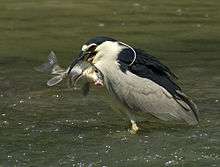Euteleostomi
| Euteleostomes Temporal range: Silurian - Present, 420–0 Ma | |
|---|---|
 | |
| A black-crowned night heron and a sucker, both members of Euteleostomi | |
| Scientific classification | |
| Kingdom: | Animalia |
| Phylum: | Chordata |
| Clade: | Teleostomi |
| Clade: | Euteleostomi |
| Subgroups | |
Euteleostomi is a successful clade that includes more than 90% of the living species of vertebrates. Euteleostomes are also known as "bony vertebrates". Both major subgroups are successful today: Actinopterygii includes the majority of extant fish species, and Sarcopterygii includes the tetrapods. "Osteichthyes" in the paleontological sense (i.e., "bony vertebrates"), is synonymous with Euteleostomi.[1] However, in ichthyology and Linnaean taxonomy Osteichthyes, literally "bony fish," refers to the paraphyletic group that differs by excluding tetrapods. The name Euteleostomi, coined as a monophyletic alternative that unambiguously includes the living tetrapods, is more widely used in bioinformatics and related fields. The term Euteleostomi comes from Eu-teleostomi, where "Eu-" comes from the Greek εὖ meaning well or good, so the clade can be defined as the living teleostomes.
Euteleostomes originally all had endochondral bone, fins with lepidotrichs (fin rays), jaws lined by maxillary, premaxillary, and dentary bones composed of dermal bone, and lungs. Many of these characters have since been lost by descendant groups, however, such as lepidotrichs lost in tetrapods, and bone lost among the chondrostean fishes. Lungs have been retained in dipnoi (lungfish), and many tetrapods (birds, mammals, reptiles, and some amphibians). In many ray-finned fishes lungs have evolved into swim bladders for regulating buoyancy, while in others they continue to be used as respiratory gas bladders.[2][3][4]
Classification
Euteleostomi contains the following subgroups:
References
- ↑ Cracraft, Joel; Donoghue, Michael J. (25 June 2004). Assembling the Tree of Life. Oxford University Press. p. 396. ISBN 978-0-19-972960-9. Retrieved 14 May 2015.
- ↑ Clack, Jennifer A. (27 June 2012). Gaining Ground, Second Edition: The Origin and Evolution of Tetrapods. Indiana University Press. pp. 21–4. ISBN 0-253-00537-X. Retrieved 12 May 2015.
- ↑ Longo, Sarah; Riccio, Mark; McCune, Amy R (2013). "Homology of lungs and gas bladders: Insights from arterial vasculature". Journal of Morphology. 274 (6): 687–703. doi:10.1002/jmor.20128. ISSN 0362-2525.
- ↑ R. McCune, Amy; C. Schimenti, John (2012). "Using Genetic Networks and Homology to Understand the Evolution of Phenotypic Traits". Current Genomics. 13 (1): 74–84. doi:10.2174/138920212799034785. ISSN 1389-2029. PMC 3269019
 . PMID 22942677.
. PMID 22942677.